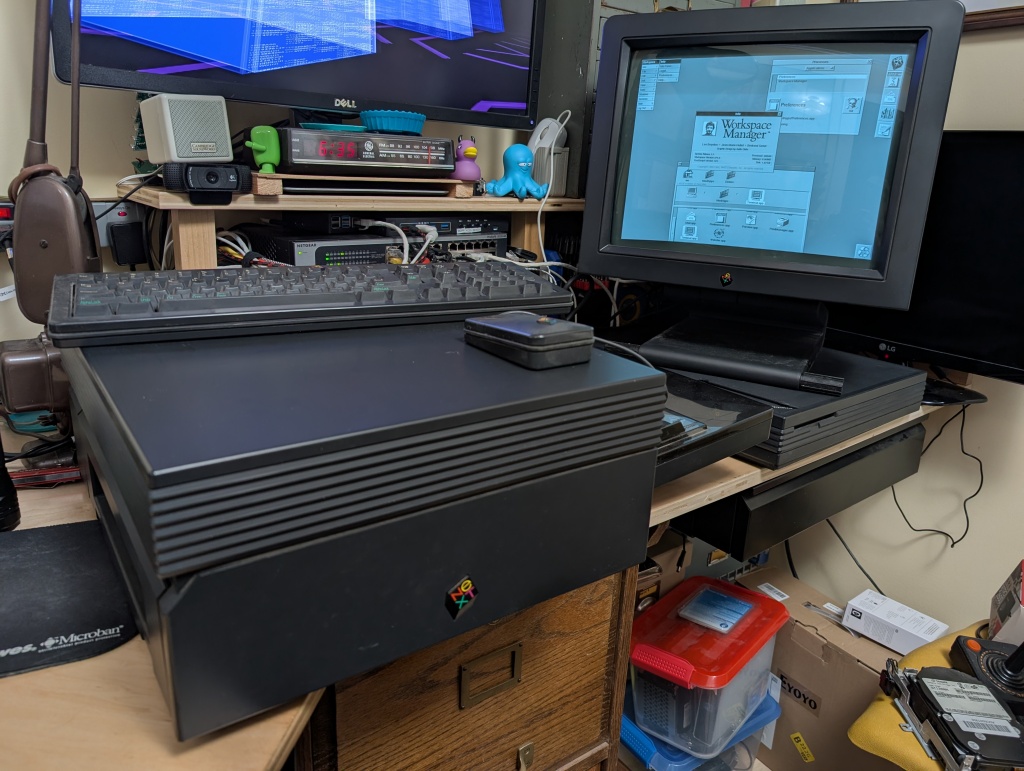Well look who is making an appearance on my bench, finally.

I was given this monitor and printer (!) last year by a coworker who used to work for NeXT back in the day. "Just get a slab" he said. "It'll be fun" he said.
Like everyone my age I've lusted after these things since 1989, but I'm also not Dr. NeXT, so there were some bumps. I found the Wombat USB -> ADB dingus that proudly Supports NeXT (fine print... very few NeXT machines have support for ADB) and so I bought a 25Mhz 68040 NeXTStation.
Unfortunately this was not one of the vanishingly few machines that supports ADB, so I was out of luck there. I kept trying to mash my Mac keyboard in until I finally actually looked at the connector. Ah well. $300 later and now I have a non-ADB keyboard and mouse. Which of course can't just plug into the NeXTStation itself. They have to go through the monitor. This is also a first-gen monitor of the type that can't be turned off, so they just burned themselves up. I do look forward to building a Non-ADB to USB dingus using the guide I found via forums, which appears to have been taken up by Adafruit.
After getting the keyboard and mouse up and running I took out the blank 200MB drive and replaced it with a BlueSCSI with a NextStep 3.3 image. I am able to get the machine on the network and pinging Internet hosts. However the Terminal.app seems insanely unstable at least on the OS image I am using. And once crashed it just can't be made to come back at all but just goes into a "launching" state in the Processes app. Know what'd be nice? Virtual Consoles. Just saying. I wonder if there's not a better PID based process viewer that can show me stuff outside my user session.
I'm basically just trying to FTP down some software to use and it's not going /super/ smoothly. But it probably is an accurate representation of the experience I'd have had as a user in a lab in 1992 or whenever.
But the party piece is that printer. That's why I'm here. And I'm happy to say it probably is capable of working. The machine sees it no problem but if I try to print I get a "Printer Door Open" error, which is a lie. It looks like there are three possible switches that get activated when the printer lid is closed, and they all seem to be fine, so this might warrant some further investigation. That is unless I just don't have the right cable since I also learned today that the "high speed serial cable" from the 68030 is not compatible with 68040 machines. So that's nice.
I can't even get my head around how rare these printers must be though. It's estimated that NeXT sold something like 50,000 workstations. My guess is most of those went to university labs and scientific installations (CERN, DUH!). Those places would have had print spoolers and maybe like 1 printer per room full of users. I can't imagine they sold more than a couple thousand of these printers and for such a minty fresh example to fall on me was just super lucky.
Whatever, I'm $1000 into this project and there's no stopping me now! Next up is to get a modern "Soundbox" replacement which will give us VGA output and a non-ADB keyboard port so we can retire the actual CRT into "Sit over there and Look Pretty" mode.
Thanks again so much Andrew for the project, and it's definitely gonna continue to be a project! Of course my goal is that this machine should work as a print spooler for my network. At least for a day or two before the power bill drives me into debtors prison.